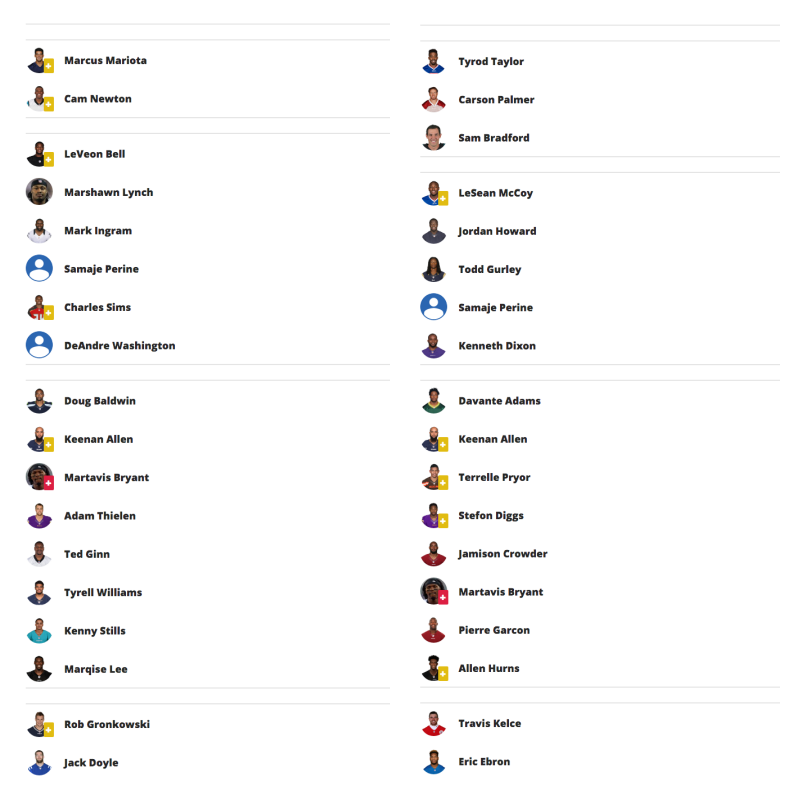NFL Best Ball Strategy: Roster Construction - Part 1
![]()
In last week’s article, I gave some guidelines for roster construction, recommending you finish your drafts with between 2-3 quarterbacks, 4-6 running backs, 6-9 wide receivers and 2-4 tight ends. Virtually any roster that allocates its picks within those ranges and drafts relatively in sync with ADP has a good shot at a solid score in one of these Draft leagues.
We want to do better than a good shot at a solid score though. Can we do better? Those are not especially narrow ranges, because the “ideal” number for each position changes depending on the players you pick. The answer to how many players to take at each position will vary from draft to draft.
This look at roster construction will have multiple parts, each focusing on a different question that I want to answer when deciding how to allocate my picks on Draft. The first, and most important:
Editor’s Note: Use promo code “GRINDERS” when you sign up for DRAFT and get a free $3 entry on DRAFT plus THREE months of RotoGrinders DRAFT Premium content!
When Did I Pick My Players?
When thinking about which position I want or need to draft next, I consider the rounds in which I drafted the players that I already have, and who is likely to be available at each position in later rounds. If we think of the midpoints of each position’s range as a baseline, we start with an expected allocation of 2.5 quarterbacks, 5 running backs, 7.5 wide receivers, and 3 tight ends. I am more likely to deviate below the baseline at a position if the players comprising it were drafted relatively early (i.e. are likely better players), and vice versa.
From that perspective, I try to stay balanced around the midpoints. To illustrate without getting too precise, here are the QB and TE guidelines with the added level of when the players were drafted (Very Early, Early, Mid, Late or Very Late).
QB (2-3):
When to Draft 2
• 1 Very Early, 1 Late/Very Late
• 2 Early/Mid
When to Draft 3
• 2 Mid, 1 Late/Very Late
• 1 Mid, 2 Late/Very Late
• 2 Late, 1 Very Late
• 3 Late
TE (2-4):
When to Draft 2
• 1 Very Early, 1 Late/Very Late
• 2 Early/Mid
When to Draft 3
• 1 Early, 2 Late/Very Late
• 1 Early, 1 Mid, 1 Late/Very Late
• 2 Mid, 1 Late/Very Late
• 3 Late
When to Draft 4
• 1 Mid, 3 Late/Very Late
• 4 Late/Very Late

At this point there is still a fair amount of ambiguity, but we have gotten significantly more precise than a simple “2-3 quarterbacks and 2-4 tight ends.” I intentionally use vague buckets like “Early” and “Late” instead of specific rounds (e.g. rounds 1-3 in place of “Early”) because the the round-by-round definitions change based on ADP. This new set of narrower guidelines does imply some commentary on current ADP and relative values, however. It’s not an accident that many of the possible combinations are not on the list. You do not see “1 Very Early, 1 Early” as a 2 QB choice because once you have paid the extremely high price to get one the of Very Early quarterback picks (e.g. Aaron Rodgers, Drew Brees), you would do more harm than good by spending an additional Early pick on a quarterback (e.g. Russell Wilson) instead of on a position that needs more help.
While I expect these definitions to change materially over the next month or two, as individual ADPs rise and fall, I want this article to be actionable, so here is how I loosely define each range based on today’s prices:

Live Examples:


Both of the rosters above are teams that I drafted in live 10-team drafts last week. For the team on the left, I stopped at two quarterbacks because my first two (Mariota and Newton) both had Early/Mid draft costs. For the team on the right, however, I felt I needed a third QB, and spent a Very Late pick on Bradford, because my first two QB picks were Mid (Taylor) and Late (Palmer) round picks. At tight end, I opted for two in both cases. The team on the left ended up with one Very Early TE (Gronkowski) and one Mid/Late TE (Doyle), while the team on the right spent an Early pick (Kelce) and a Mid round pick (Ebron).
Because there are so many possible combinations at running back and wide receiver, it would not make sense to write out “Early/Mid/Late” guidelines, but the same principles apply when weighing your options at those positions. Four wide receivers who were each selected in the first four rounds of the draft do not offer the same production or risk as four receivers from the last four rounds of the draft, and we need to balance our allocation accordingly. If you are investing heavily at either position early in the draft, then, all else equal, you will want to gravitate toward the lower end of its recommended range.
Conclusion
I do not believe that there is one “optimal” roster construction, and hopefully this article has helped illustrate the fluidity of the process. We could go through the results of optimizations and simulations (I have, and eventually we probably will), but the primary objective is to establish a good framework for thinking about the shape of your roster. Keep tabs on your investment at each position as you progress through each draft and you will find yourself in good shape when all the picks have been made.
Eventually, between a few key concepts and getting some drafts under your belt, sizing up a roster and identifying its strengths and weaknesses will become second nature.